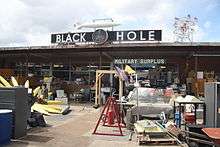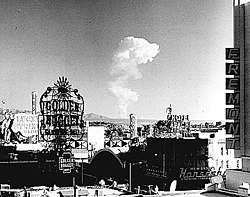Atomic tourism
Atomic tourism is a recent form of tourism in which visitors learn about the Atomic Age by traveling to significant sites in atomic history such as museums with atomic weapons, missile silos, vehicles that carried atomic weapons or sites where atomic weapons were detonated.[1][2]

In the United States, the Center for Land Use Interpretation has conducted tours of the Nevada Test Site, Trinity Site, Hanford Site, and other historical atomic age sites, to explore the cultural significance of these Cold War nuclear zones. The book Overlook: Exploring the Internal Fringes of America describes the purpose of this tourism as "windows into the American psyche, landmarks that manifest the rich ambiguities of the nation's cultural history."[3][4][5] A Bureau of Atomic Tourism was proposed by American photographer Richard Misrach and writer Myriam Weisang Misrach in 1990.[6][7]
The phenomenon is not exclusive to North America. Visitors to the Chernobyl Exclusion Zone often visit the nearly deserted city of Pripyat.[1] The Hiroshima Peace Memorial (Genbaku Dome), which survived the destruction of Hiroshima, is now a UNESCO World Heritage site at the center of Hiroshima Peace Memorial Park.[8] Bikini Atoll was at one time the site of a diving tourism initiative.[9] As of 2012, China planned to build a tourist destination at its first atomic test site, the Malan Base at Lop Nur in the Xinjiang Uyghur Autonomous Region.[10]
During the early atomic age when fission was viewed as a sign of progress and modernity, the city of Las Vegas and its Chamber of Commerce nicknamed Vegas as the "Atomic City" in the mid 1940s and early 1950s in an attempt to attract tourists.[11][12][13] So called "bomb viewing parties" took place on desert hilltops, or more famously at the panoramic Sky Room at the Desert Inn, and casinos held Miss Atomic pageants while serving Atomic Cocktails.[14][15]<[16]
.jpg)
.jpg)

Atomic museums
Research and production
- Los Alamos Historical Museum, Los Alamos, New Mexico - items from the Manhattan Project
- Bradbury Science Museum, Los Alamos, New Mexico - history of the Manhattan Project
- X-10 Graphite Reactor, Oak Ridge, Tennessee - first nuclear reactor to produce Plutonium 239
- Savannah River Site, South Carolina - production site of plutonium and tritium
- Experimental Breeder Reactor I, Arco, Idaho - first nuclear reactor to produce electrical power, first breeder reactor, and first reactor to use plutonium as fuel
- Obninsk Nuclear Power Plant, Obninsk - the first nuclear reactor in the world that produced commercial electricity
- Hanford Site, Washington - location of the B Reactor which produced some of the plutonium for the Trinity test and the Fat Man bomb
- George Herbert Jones Laboratory, Chicago, Illinois - where plutonium was first isolated and characterized
- American Museum of Science and Energy, Oak Ridge, Tennessee - bomb casings
- National Atomic Testing Museum, Las Vegas, Nevada - Nevada Test Site
- Strategic missile forces museum in Ukraine, Ukraine
- National Museum of Nuclear Science & History, Albuquerque, New Mexico
Delivery vehicles
- Tinian Airfield, Northern Mariana Islands - launch site for the atomic bombings of Hiroshima and Nagasaki, Japan during World War II
- Titan Missile Museum, Sahuarita, Arizona - public underground missile museum
- Nike Missile Site SF-88, Marin County, California - fully restored Nike missile complex
- Ronald Reagan Minuteman Missile State Historic Site, Cooperstown, North Dakota - last surviving complete facilities from USAF 321st Missile Wing (01Nov63-30Sep98), namely Oscar-Zero Missile Alert Facility (4 mi N of Cooperstown) and November-33 Launch Facility (missile silo, 2 mi E of Cooperstown)
- National Museum of Nuclear Science & History, Albuquerque, New Mexico - missiles and rockets
- National Museum of the United States Air Force, Dayton, Ohio - the Nagasaki B-29 bomber (Bockscar) and missiles
- National Air and Space Museum, Washington, D.C. - the Hiroshima B-29 bomber (Enola Gay)
- White Sands Missile Range, New Mexico
- Air Force Space and Missile Museum, Cape Canaveral Air Force Station, Florida
- Air Force Armament Museum, Eglin Air Force Base, Florida
- Minuteman Missile National Historic Site, Wall, South Dakota - Launch Control Facility Delta-01 with its corresponding underground Launch Control Center and Launch Facility (Missile Silo) Delta-09
- South Dakota Air and Space Museum, Ellsworth Air Force Base, Box Elder, South Dakota - Minuteman Missile Transporter truck, 44th Missile Wing Training Launch Facility (Training Missile Silo)
- Strategic Air Command & Aerospace Museum, Ashland, Nebraska - a museum focusing on aircraft and nuclear missiles of the United States Air Force
Miscellaneous


- Greenbrier Bunker, Greenbrier County, West Virginia - underground bunker for the United States Congress
- Hiroshima Peace Memorial Park, Hiroshima - contains the Hiroshima Peace Memorial, Hiroshima Peace Memorial Museum, and related memorials
- Nagasaki Peace Park and Nagasaki Atomic Bomb Museum, Nagasaki
- The Daigo Fukuryū Maru ship, a Japanese fishing boat that was contaminated after the Castle Bravo detonation in 1954, it is now on display in Tokyo at the Tokyo Metropolitan Daigo Fukuryū Maru Exhibition Hall.[17]
- CFS Carp - also known as The Diefenbunker, a cold war nuclear museum in a former underground Canadian military facility outside of Ottawa
- Chernobyl Museum, Kiev
- Hack Green Secret Nuclear Bunker, Cheshire countryside near the town on Nantwich, UK[18]
- Kelvedon Hatch Secret Nuclear Bunker
- Waste Isolation Pilot Plant Field Office exhibit hall
Atomic Mines
- Port Radium on Canada's Great Bear Lake site of a uranium mine important to the Manhattan Project
Explosion sites

- Trinity Site, Socorro County, New Mexico - site of the first artificial nuclear explosion
- Nevada Test Site, Nye County, Nevada - US nuclear test site
- Pacific Proving Grounds, US nuclear test site
- Carson National Forest, Rio Arriba County, New Mexico - site of Project Gasbuggy
- Carlsbad, New Mexico - site of Project Gnome
- Rio Blanco County, Colorado - site of Project Rio Blanco
- Parachute, Colorado - site of Project Rulison
- Hiroshima, first wartime use of an atomic bomb
- Nagasaki, last wartime use of an atomic bomb
- Maralinga, South Australia - site of Operation Buffalo and Operation Antler
- Pokhran, Rajasthan - site of the Pokhran-II test
Atomic accidents
- The Chernobyl disaster was the worst nuclear power plant accident in history. Tourists can access the exclusion zone surrounding the plant, and in particular the abandoned city of Prypiat.[19][20][21][22]
- Three Mile Island was the site of a well publicized accident, the most significant in the history of American commercial nuclear power. The Three Mile Island Visitor Center, in Middletown, PA, educates the public through exhibitions and video displays.[23]
- Windscale fire On October 10, 1957, the graphite core of a British nuclear reactor at Windscale, Cumbria, caught fire, releasing substantial amounts of radioactive contamination into the surrounding area. The event, known as the Windscale fire, was considered the world's worst reactor accident until the Three Mile Island accident in 1979. Both incidents were dwarfed by the magnitude of the Chernobyl disaster in 1986. The Visitor Center was closed in 1992, and the public may no longer visit, it has been turned into a center for supplier conferences, and business events.[24]
Literary and cinematic works on atomic tourism
The novel O-Zone, by Paul Theroux, involves a group of wealthy New York tourists who enter and party in a post-nuclear disaster zone in the Ozarks. [25]
References
- Boyle, Rebecca (2017). "Greetings from Isotopia". Distillations. 3 (3): 26–35. Retrieved June 14, 2018.
- Italie, Leanne (March 30, 2011). "Japan disaster boosts interest in atomic tourism". AZ Central/Associated Press. Retrieved 15 June 2018.
- Sayer, Kyeann. "Overlook: Exploring the Internal Fringes of America with the Center for Land Use Interpretation". treehugger.com. Treehugger. Retrieved 19 October 2014.
- Center for Land Use Interpretation. "Open House at the Nevada Test Site: And a Glimpse of what a Nuclear Test Site Tourist Attraction Might be Like". CLUI.ORG. Center for Land Use Interpretation. Retrieved 19 October 2014.
- Coolidge, edited by Matthew; Simons, Sarah; Rugoff (forward), Ralph (2006). Overlook : exploring the internal fringes of America with the Center for Land Use Interpretation. New York: Metrolpolis Books. ISBN 978-1933045337. Retrieved 19 October 2014.CS1 maint: extra text: authors list (link)
- Misrach, Richard; Weisang Misrach, Myriam (1990). Bravo 20: The Bombing of the American West. Baltimore: Johns Hopkins University Press. ISBN 978-0801840647.
- Beck, John (2009). Dirty wars landscape, power, and waste in western American literature. Lincoln: University of Nebraska Press. p. 332. ISBN 9780803226692.
- UNESCO. "Hiroshima Peace Memorial (Genbaku Dome)".
- Gwynne, S. C. (October 17, 2012). "Paradise With an Asterisk". Outside. Retrieved 15 June 2018.
- "Former Chinese nuclear bomb base turned into tourist attraction". CNN Travel. 17 October 2012. Retrieved 15 June 2018.
- "How 1950s Las Vegas sold atomic bomb testing as tourism". /www.si.edu/. Retrieved 7 February 2019.
- "Atomic tests were a tourist draw in 1950s Las Vegas". citylab.com. Retrieved 7 February 2019.
- "Atomic Cocktail". diffordsguide.com. Retrieved 7 February 2019.
- "Who are you miss atomic bomb". popularmechanics.com. Retrieved 25 February 2019.
- "Nuclear Tourism Travels in the Shadow of the Bomb". telegraph.co.uk. Retrieved 25 February 2019.
- "National Atomic Testing Museum". National Atomic Testing Museum in Association with the Smithsonian Institution. Retrieved 16 June 2019.
- 都立 第五福竜丸展示館 Official Site
- Hack Green. "Hack Green Secret Nuclear Bunker". hackgreen.co.uk. Hack Green Nuclear Bunker. Archived from the original on 25 August 2014. Retrieved 19 October 2014.
- New Sight in Chernobyl's Dead Zone: Tourists - New York Times
- Bleak-o Tourism, Welcome to Chernobyl - Lonely Planet Travel Archived April 9, 2011, at the Wayback Machine
- Morris, Holly. "Sex and drugs and radiation: Dare-devil 'stalkers' illegally enter Chernobyl's Dead Zone". The Independent. The Independent UK. Retrieved 18 October 2014.
- Morris, Holly. "The Stalkers Inside the bizarre subculture that lives to explore Chernobyl's Dead Zone". Slate.com article from Roads & Kingdoms series. Slate. Retrieved 18 October 2014.
- "Three Mile Island Visitors Center Attraction Details". explorepahistory.com. Explore PA History. Retrieved 19 October 2014.
- "Seascale - Sellafied Nuclear Reprocessing Facility". visitcumbria.com. Visit Cumbria. Retrieved 19 October 2014.
- PN Review. "Missouri Breaks: Paul Therous, O-Zone". PN Review. Retrieved 19 December 2014.
External links
| Wikimedia Commons has media related to Atomic tourism. |
| Wikivoyage has a travel guide for Nuclear tourism. |